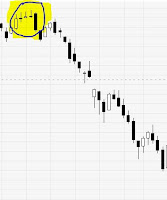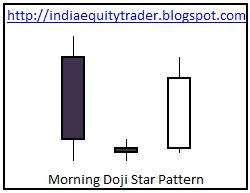I am back. Been too busy exploring new city and visiting places and it is nothing short of wonder that I still find time to write. I must be addicted I guess. Will go to JM for rehab once I am back.
Coming back to the Candlestick Patterns... today it is turn of Three White Soldiers and Three Black Crows. Both these do not occur as often as the major reversal patterns and hence are called secondary patterns. Though uncommon (just like common sense) they are very strong and reliable indicators.
Three White Soldiers
Have a look at the pattern here.
This pattern is characterized by three consecutive White (Green) candles where each candle opens within the body of previous candle and closes above it. The close is usually at or near day's high. This pattern usually occurs at the end of a long down or sideways move.
First candle indicates the exhaustion of current trend by indicating a close near day's high. Second day the price opens lower indicating sellers are still present in the market but as the day progresses, buyers overwhelm them. This is repeated again on third day indicating a definitive trend reversal.
Three Black Crows
The Pattern.
In one sentence; this is Three Black Soldiers pattern.
It is named after crows probably because Japanese people think of crows as evil birds. Needless to say, this pattern appears after a long uptrend indicating the reversal. First day indicating the change in trend and second, third days indicating unsuccessful denial by buyers. This pattern is further strong if price closes at or near day's low.
I am not posting a example of these patterns here but will mention one. Around middle of March 09 when NIFTY was around 2550-2600 level after prolonged downtrend, Three White Soldiers appeared. What followed was one of the most spectacular bullish phase taking NIFTY to above 4600 by Mid Jun (over 2000 points in 3 months) and above 5000 by Nov.
Will come back soon with the final multi-candlestick pattern. Then we proceed to charts and patterns in them along with indicators and oscillators. Can't wait to get there. It will be fun for sure.
Will try to post one today at Options Blog and will try to revive Futures Blog too. Till then, enjoy rehab.

















